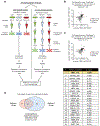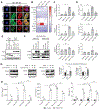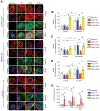Phosphorylation of RAB7 by TBK1/IKKε Regulates Innate Immune Signaling in Triple-Negative Breast Cancer
- PMID: 31662325
- PMCID: PMC6942622
- DOI: 10.1158/0008-5472.CAN-19-1310
Phosphorylation of RAB7 by TBK1/IKKε Regulates Innate Immune Signaling in Triple-Negative Breast Cancer
Abstract
Triple-negative breast cancer (TNBC) is a heterogeneous disease enriched for mutations in PTEN and dysregulation of innate immune signaling. Here, we demonstrate that Rab7, a recently identified substrate of PTEN phosphatase activity, is also a substrate of the innate immune signaling kinases TANK-binding kinase 1 (TBK1)/IκB kinase ε (IKKε) on the same serine-72 (S72) site. An unbiased search for novel TBK1/IKKε substrates using stable isotope labeling with amino acids in cell culture phosphoproteomic analysis identified Rab7-S72 as a top hit. PTEN-null TNBC cells expressing a phosphomimetic version of Rab7-S72 exhibited diffuse cytosolic Rab7 localization and enhanced innate immune signaling, in contrast to a kinase-resistant version, which localized to active puncta that promote lysosomal-mediated stimulator of interferon genes (STING) degradation. Thus, convergence of PTEN loss and TBK1/IKKε activation on Rab7-S72 phosphorylation limited STING turnover and increased downstream production of IRF3 targets including CXCL10, CCL5, and IFNβ. Consistent with this data, PTEN-null TNBC tumors expressed higher levels of STING, and PTEN-null TNBC cell lines were hyperresponsive to STING agonists. Together, these findings begin to uncover how innate immune signaling is dysregulated downstream of TBK1/IKKε in a subset of TNBCs and reveals previously unrecognized cross-talk with STING recycling that may have implications for STING agonism in the clinic. SIGNIFICANCE: These findings identify Rab7 as a substrate for TBK1 for regulation of innate immune signaling, thereby providing important insight for strategies aimed at manipulating the immune response to enhance therapeutic efficacy in TNBC.
©2019 American Association for Cancer Research.
Conflict of interest statement
Conflict of Interest Statement. T.U.B. is a consultant for N-of-One/Qiagen. D.A.B. is consultant for N-of-One/Qiagen, Tango Therapeutics, and MADALON consulting. D.A.B. is cofounder of Xsphera Biosciences. D.A.B has received research funding from Novartis and Bristol Myers Squibb.
Figures






Similar articles
-
TBK1 and IKKε Act Redundantly to Mediate STING-Induced NF-κB Responses in Myeloid Cells.Cell Rep. 2020 Apr 7;31(1):107492. doi: 10.1016/j.celrep.2020.03.056. Cell Rep. 2020. PMID: 32268090
-
The Kinase MAP4K1 Inhibits Cytosolic RNA-Induced Antiviral Signaling by Promoting Proteasomal Degradation of TBK1/IKKε.Microbiol Spectr. 2021 Dec 22;9(3):e0145821. doi: 10.1128/Spectrum.01458-21. Epub 2021 Dec 15. Microbiol Spectr. 2021. PMID: 34908452 Free PMC article.
-
Mechanism of endogenous regulation of the type I interferon response by suppressor of IκB kinase epsilon (SIKE), a novel substrate of TANK-binding kinase 1 (TBK1).J Biol Chem. 2013 Jun 21;288(25):18612-23. doi: 10.1074/jbc.M112.440859. Epub 2013 May 6. J Biol Chem. 2013. PMID: 23649622 Free PMC article.
-
The non-canonical IκB kinases IKKε and TBK1 as potential targets for the development of novel therapeutic drugs.Curr Mol Med. 2013 Aug;13(7):1089-97. doi: 10.2174/1566524011313070004. Curr Mol Med. 2013. PMID: 23157677 Review.
-
IκB kinase ε (IKKε): a therapeutic target in inflammation and cancer.Biochem Pharmacol. 2013 Apr 1;85(7):873-80. doi: 10.1016/j.bcp.2013.01.007. Epub 2013 Jan 17. Biochem Pharmacol. 2013. PMID: 23333767 Free PMC article. Review.
Cited by
-
The Regulation of Rab GTPases by Phosphorylation.Biomolecules. 2021 Sep 10;11(9):1340. doi: 10.3390/biom11091340. Biomolecules. 2021. PMID: 34572553 Free PMC article. Review.
-
LMTK3 regulation of EV biogenesis and cargo sorting promotes tumour growth by reducing monocyte infiltration and driving pro-tumourigenic macrophage polarisation in breast cancer.Mol Cancer. 2025 May 23;24(1):149. doi: 10.1186/s12943-025-02346-2. Mol Cancer. 2025. PMID: 40405280 Free PMC article.
-
Tumor Mutation Burden and Immune Invasion Characteristics in Triple Negative Breast Cancer: Genome High-Throughput Data Analysis.Front Immunol. 2021 Apr 21;12:650491. doi: 10.3389/fimmu.2021.650491. eCollection 2021. Front Immunol. 2021. PMID: 33968045 Free PMC article.
-
Coordinated inflammation and immune response transcriptional regulation in breast cancer molecular subtypes.Front Immunol. 2024 Jun 25;15:1357726. doi: 10.3389/fimmu.2024.1357726. eCollection 2024. Front Immunol. 2024. PMID: 38983850 Free PMC article.
-
MPS1 inhibition primes immunogenicity of KRAS-LKB1 mutant lung cancer.Cancer Cell. 2022 Oct 10;40(10):1128-1144.e8. doi: 10.1016/j.ccell.2022.08.015. Epub 2022 Sep 22. Cancer Cell. 2022. PMID: 36150391 Free PMC article.
References
-
- Carey LA, Dees EC, Sawyer L, Gatti L, Moore DT, Collichio F, et al. The triple negative paradox: primary tumor chemosensitivity of breast cancer subtypes. Clin Cancer Res 2007;13:2329–34 - PubMed
-
- Liedtke C, Mazouni C, Hess KR, Andre F, Tordai A, Mejia JA, et al. Response to neoadjuvant therapy and long-term survival in patients with triple-negative breast cancer. J Clin Oncol 2008;26:1275–81 - PubMed
-
- Phuah SY, Looi LM, Hassan N, Rhodes A, Dean S, Taib NA, et al. Triple-negative breast cancer and PTEN (phosphatase and tensin homologue) loss are predictors of BRCA1 germline mutations in women with early-onset and familial breast cancer, but not in women with isolated late-onset breast cancer. Breast Cancer Res 2012;14:R142. - PMC - PubMed
Publication types
MeSH terms
Substances
Grants and funding
LinkOut - more resources
Full Text Sources
Research Materials
Miscellaneous

